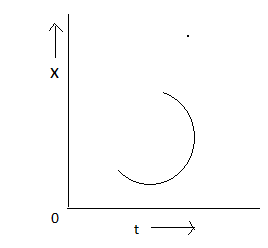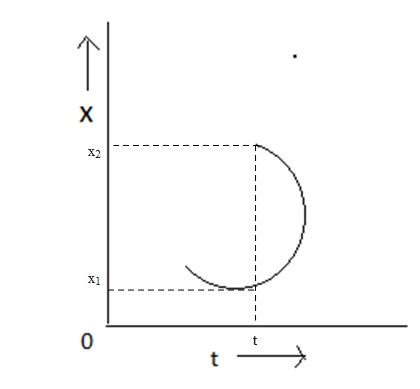
The graph of position- time shown in the figure for a particle is not possible because


Answer
557.4k+ views
Hint: Position- time graphs are generally used to describe the motion that the object is following. We take x-axis to denote time and y-axis to denote its position. The velocity is the slope of this position-time graph. As the steepness of the graph is increasing it has greater the value of its velocity. The velocity changes with the change in its slope always. That is, both the quantities are interrelated.
Complete step-by-step answer:

Since ${{x}_{1}}$ and ${{x}_{2}}$ are two positions at the same time it is not possible.
Position- time graphs are generally used to describe the motion that the object is following. We take x-axis to denote time and y-axis to denote its position. The velocity is the slope of this position-time graph. As the steepness of the graph is increasing it has greater the value of its velocity. The velocity changes with the change in its slope always. That is, both the quantities are interrelated. The position- time graph can be negative whenever the velocity is negative. If the position- time graph has a constant slope then it has a constant velocity.
Note: If the position- time graph has a constant slope then it has a constant velocity. As the steepness of the graph is increasing it has greater the value of its velocity. The velocity changes with the change in its slope always. The velocity is the slope of this position-time graph. Since ${{x}_{1}}$ and ${{x}_{2}}$ are two positions at the same time it is not possible in the case of a position-time graph.
Complete step-by-step answer:

Since ${{x}_{1}}$ and ${{x}_{2}}$ are two positions at the same time it is not possible.
Position- time graphs are generally used to describe the motion that the object is following. We take x-axis to denote time and y-axis to denote its position. The velocity is the slope of this position-time graph. As the steepness of the graph is increasing it has greater the value of its velocity. The velocity changes with the change in its slope always. That is, both the quantities are interrelated. The position- time graph can be negative whenever the velocity is negative. If the position- time graph has a constant slope then it has a constant velocity.
Note: If the position- time graph has a constant slope then it has a constant velocity. As the steepness of the graph is increasing it has greater the value of its velocity. The velocity changes with the change in its slope always. The velocity is the slope of this position-time graph. Since ${{x}_{1}}$ and ${{x}_{2}}$ are two positions at the same time it is not possible in the case of a position-time graph.
Recently Updated Pages
Why are manures considered better than fertilizers class 11 biology CBSE

Find the coordinates of the midpoint of the line segment class 11 maths CBSE

Distinguish between static friction limiting friction class 11 physics CBSE

The Chairman of the constituent Assembly was A Jawaharlal class 11 social science CBSE

The first National Commission on Labour NCL submitted class 11 social science CBSE

Number of all subshell of n + l 7 is A 4 B 5 C 6 D class 11 chemistry CBSE

Trending doubts
What is meant by exothermic and endothermic reactions class 11 chemistry CBSE

10 examples of friction in our daily life

One Metric ton is equal to kg A 10000 B 1000 C 100 class 11 physics CBSE

1 Quintal is equal to a 110 kg b 10 kg c 100kg d 1000 class 11 physics CBSE

Difference Between Prokaryotic Cells and Eukaryotic Cells

What are Quantum numbers Explain the quantum number class 11 chemistry CBSE




